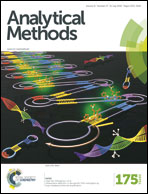Surfactant-based dispersive liquid–liquid microextraction for the determination of zinc in environmental water samples using flame atomic absorption spectrometry
Abstract
Zinc metal is an essential micronutrient which is required for different biological and physiological processes in humans, animals and plants. Here, a simple, rapid and sensitive method for the determination of zinc in environmental water samples using surfactant-assisted dispersive liquid–liquid micro-extraction (SA-DLLME) prior to flame atomic absorption spectrometry (FAAS) analysis has been reported. This method involved the formation of a zinc complex with 4-(2-pyridylazo) resorcinol (PAR) and subsequently SA-DLLME was applied to extract the Zn(II)–(PAR)2·CPC complex into chloroform in the presence of a cationic surfactant. Optimum extraction of the complex was observed when the concentration of cetylpyridinium chloride (CPC) and PAR was 0.1% for both at pH 9.0 and with an extraction time of 10 min. The calibration curve was found to be linear over the range of 1.5–60 μg L−1 with a correlation of estimation (r2) of 0.997. This optimized method has been successfully applied for the determination of zinc in environmental water (tap, river and well) samples.


 Please wait while we load your content...
Please wait while we load your content...